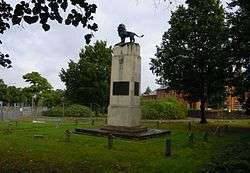8th Infantry Division (United Kingdom)
| 8th Division 8th Infantry Division | |
|---|---|
|
Insignia of the 8th Division, World War I. | |
| Active |
1914–19 1938–40 |
| Country |
|
| Branch |
|
| Type | Infantry |
| Size | Division |
| Engagements |
Battle of Neuve Chapelle Battle of Aubers Ridge Battle of the Somme Battle of Passchendaele |
| Commanders | |
| Notable commanders |
Bernard Montgomery Reade Godwin-Austen William Heneker |
The 8th Infantry Division was an infantry division of the British Army that was active in both World War I and World War II. The division was first formed in October 1914 during World War I, initially consisting mainly of soldiers of the Regular Army and served on the Western Front throughout the war, sustaining many casualties, before disbandment in 1919. The division was reactivated in Palestine, under the command of Major-General Bernard Montgomery, in the late 1930s in the years running up to the Second World War before being disbanded in late February 1940.
History

The 8th Division was a Regular Army division that was formed by combining battalions returning from outposts in the British Empire at the outbreak of the First World War. Major-General Francis Davies took command on 19 September 1914. The division moved to France in November, 1914, following the First Battle of Ypres. The division fought on the Western Front for the duration of the war, taking part in the Battle of Neuve Chapelle, the Battle of Aubers Ridge, both in 1915, the Battle of the Somme, in 1916, and the Battle of Passchendaele in 1917.
Brigadier-General R. Oxley took acting command of the Division on 27 July 1915, being succeeded by Major-General Havelock Hudson on 1 August 1915. Major-General W. Heneker took over on 10 December 1916.
Major-General Bernard Montgomery commanded the 8th Infantry Division from 1938 to July 1939, followed by Major-General Reade Godwin-Austen.
The 8th Infantry Division was never a complete formation during the Second World War. In 1939 it was based in Palestine and consisted of two infantry brigades (14th and 16th Brigades). Due to the needs of defence against German and Italian forces these units were sent to places of need and reformed as different formations. Although it had infantry it had no divisional troops due to the shortage of artillery and engineers in the Middle East.
First World War Composition

- 2nd Battalion, Devonshire Regiment
- 2nd Battalion, Prince of Wales's Own (West Yorkshire Regiment)
- 2nd Battalion, Cameronians (Scottish Rifles) (until February 1918)
- 1/6th Battalion, Cameronians (Scottish Rifles) (from March 1915 until June 1915)
- 2nd Battalion, Middlesex Regiment
- 1/7th Battalion, Middlesex Regiment (from March 1915 until February 1916)
- 1st Battalion, Worcestershire Regiment
- 1st Battalion, Sherwood Foresters
- 2nd Battalion, Northamptonshire Regiment
- 1/5th Battalion, the Black Watch (until October 1915)
- 2nd Battalion, East Lancashire Regiment (to 25th Bde. February 1918)
- 1/4th Battalion, Queen's Own Cameron Highlanders (from February 1915 until April 1915)
Between October 1915 and July 1916, the 24th Brigade swapped with the 70th Brigade from the 23rd Division.
- 2nd Battalion, Princess Charlotte of Wales's (Royal Berkshire Regiment)
- 2nd Battalion, Rifle Brigade
- 1st Battalion, Royal Irish Rifles (until February 1918)
- 2nd Battalion, Lincolnshire Regiment (until February 1918)
- 2nd Battalion, East Lancashire Regiment (from 24th Bde. February 1918)
- 1/8th Battalion, Middlesex Regiment (from August 1915 until October 1915)
- 1/13th (Princess Louise) Kensington Battalion, London Regiment (until May 1915)
- 1/1st (City of London) Battalion, London Regiment (from May 1915 until February 1916)
The 70th Brigade was from the 23rd Division and was attached to the 7th Division between October 18, 1915 and July 15, 1916, swapping with the 24th Brigade.
- Artillery on formation
- V Brigade, Royal Horse Artillery
- XXXIII Brigade, Royal Field Artillery
- XLV Brigade, Royal Field Artillery
Structure in 1939
Order of battle in 1939:[1]
- 14th Infantry Brigade
- Brigadier G. Dawes
- 2nd Battalion, Queen's Royal Regiment (West Surrey)
- 1st Battalion, Argyll and Sutherland Highlanders
- 2nd Battalion, Rifle Brigade
- 16th Infantry Brigade
- Brigadier C.E.N. Lomax
- 2nd Battalion, Leicestershire Regiment
- 1st Battalion, South Staffordshire Regiment
- 1st Battalion, Welch Regiment
- 1st Battalion, Sherwood Foresters
- 12th Field Company, Royal Engineers
- A divisional reconnaissance regiment of the Royal Armoured Corps
General Officers Commanding
Commanders included:[2]
- 1902–1903 Major-General Sir Hugh McCalmont
- 1903–1905 Major-General Sir Reginald Pole-Carew
- 1905–1906 Major-General Sir William Knox
- 1906–1907 Major-General Lawrence Parsons
- World War I[3]
- 19 September 1914 Major-General F.J. Davies
- 27 July 1915 Brigadier-General R. S. Oxley (acting)
- 1 August 1915 Major-General H. Hudson
- 10 December 1916 Major-General W. C. G. Heneker
- World War II
- 1938–1939 Major-General Bernard Montgomery
- 1939–1940 Major-General Reade Godwin-Austen
See also
- List of British divisions in World War I
- List of British divisions in World War II
- British Army Order of Battle (September 1939)
Notes and references
- ↑ Orbat.com/Niehorster
- ↑ Army Commands Archived 5 July 2015 at the Wayback Machine.
- ↑ Becke 1935, p. 89
Bibliography
Further reading
- Boraston, J. H.; Bax, C. E. O. (1926). The Eighth Division in War 1914–1918 (N & M Press 1999 ed.). London: Medici Society. ISBN 1-897632-67-3.
